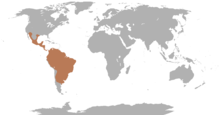Peccaries
| Peccaries Temporal range: 33.9–0 Ma Late Eocene – Holocene |
|
|---|---|
 |
|
| Collared peccary, Pecari tajacu | |
| Scientific classification | |
| Kingdom: | Animalia |
| Phylum: | Chordata |
| Class: | Mammalia |
| Order: | Artiodactyla |
| Suborder: | Suina |
| Family: |
Tayassuidae Palmer, 1897 |
| Genera | |
 |
|
| Range of the peccaries | |
| Synonyms | |
|
Dicotylidae |
|
Dicotylidae
A peccary (also javelina or skunk pig) is a medium-sized hoofed mammal of the family Tayassuidae (New World pigs) in the suborder Suina along with the Old World pigs, Suidae. They are found throughout Central and South America and in the southwestern area of North America. Peccaries usually measure between 90 and 130 cm (3.0 and 4.3 ft) in length, and a full-grown adult usually weighs about 20 to 40 kg (44 to 88 lb).
Peccaries, which are native to the Americas, are often confused with the pig family that originated in Afro-Eurasia, especially since some domestic pigs brought by European settlers have escaped over the years and now run wild as "razorback" hogs in many parts of the United States.
In many countries, especially in the developing world, they are raised on farms as a source of food for local communities.
The word peccary is derived from the Carib word pakira or paquira. In Portuguese, a peccary is called pecari, porco-do-mato, queixada, or tajaçu, among other names; in Spanish, "javelina", jabalí, sajino, or pecarí; in French Guiana and Suriname, pakira.
A peccary is a medium-sized animal, with a strong resemblance to a pig. Like a pig, it has a snout ending in a cartilaginous disc, and eyes that are small relative to its head. Also like a pig, it uses only the middle two digits for walking, although, unlike pigs, the other toes may be altogether absent. Its stomach is not ruminating, although it has three chambers, and is more complex than those of pigs.
...
Wikipedia
